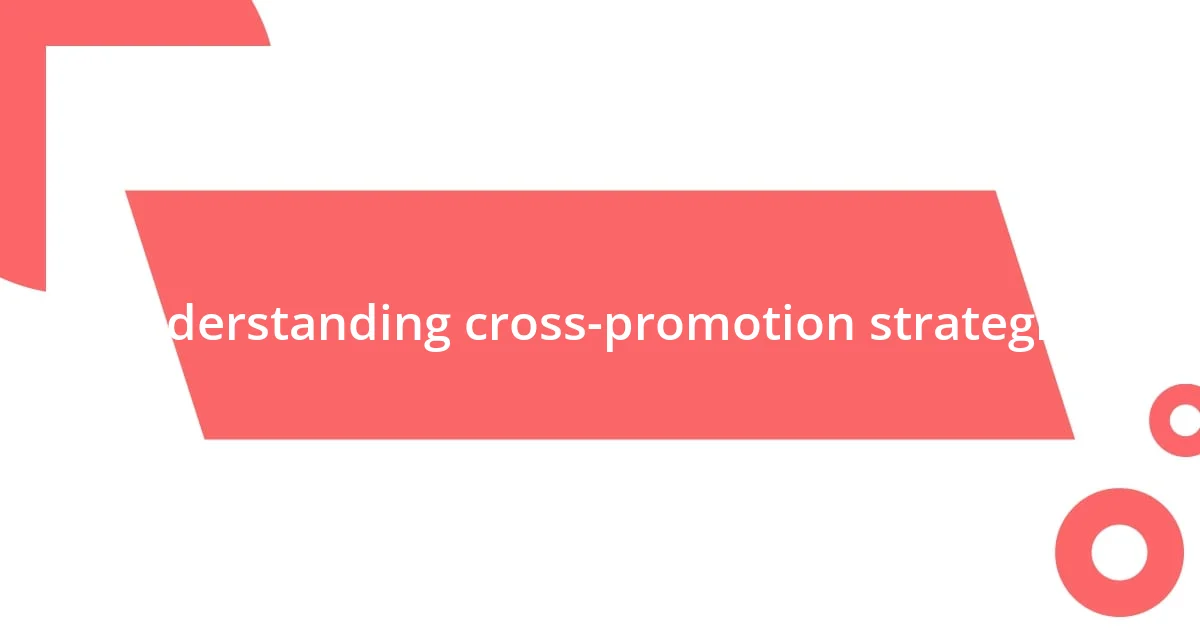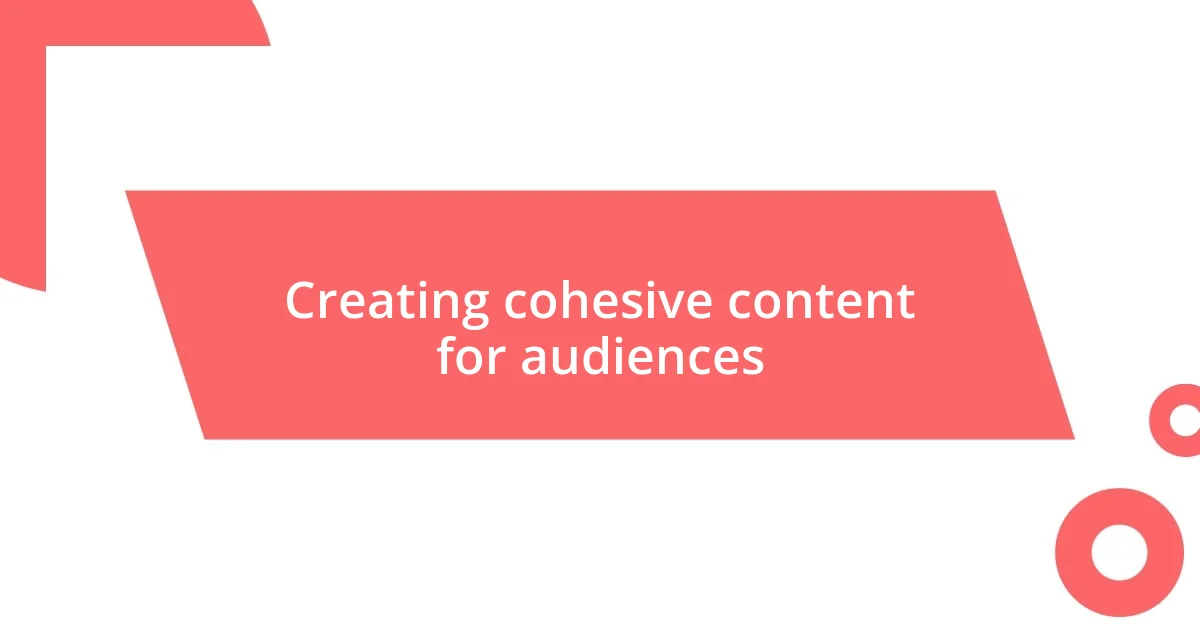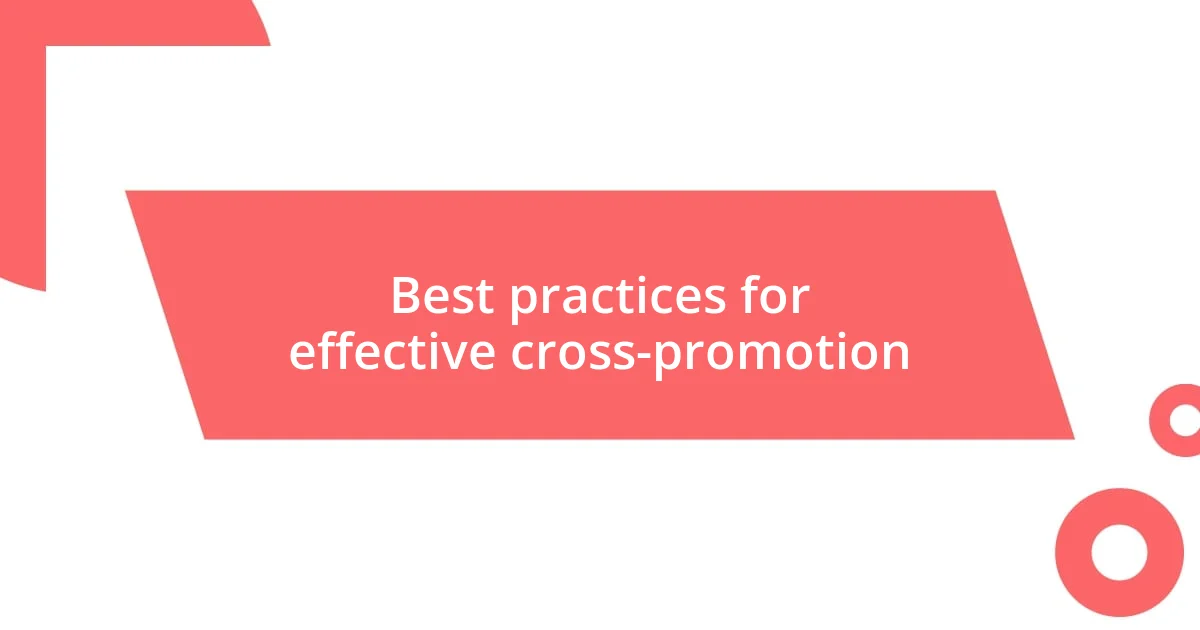Key takeaways:
- Understanding audience preferences across platforms enables effective cross-promotion, enhancing engagement and creating a cohesive brand experience.
- Tailoring content, visuals, and calls to action for each platform significantly improves interaction and fosters loyalty among followers.
- Leveraging analytics to assess performance and audience insights informs future strategies, facilitating continuous improvement in campaign effectiveness.

Understanding cross-promotion strategies
Cross-promotion strategies are all about leveraging your existing audience to grow your reach on different platforms. I remember when I decided to link my blog with my social media channels. At first, I hesitated, wondering if my audience would connect. But the engagement I saw was eye-opening, proving that my followers appreciated consistent content across different mediums.
One of the key elements in these strategies involves knowing where your audience spends their time. Have you ever thought about the platforms your audience frequents? I found that by analyzing my analytics data, it became clear that my followers preferred Instagram for quick updates and my blog for in-depth articles. This insight allowed me to craft tailored posts that directed traffic seamlessly from one platform to another.
Perhaps the most rewarding aspect of cross-promotion is creating a cohesive brand experience. When I aligned my messaging and visuals across platforms, I felt a stronger connection with my audience. They began to recognize my style, which created a sense of community. Isn’t it amazing how that consistency can transform casual followers into loyal fans?

Identifying suitable platforms for promotion
Identifying the right platforms for promotion can feel overwhelming, but it’s crucial. I often start by thinking about where my target audience engages most. For example, during my first attempts at cross-promoting, I initially focused on every social media channel available. However, I quickly realized that my audience didn’t resonate equally across all platforms. This led me to prioritize those where I saw the most engagement and interaction.
Here are some effective ways to identify suitable platforms for your promotion:
- Analyze Engagement Metrics: Look at where you get the most likes, shares, and comments.
- Survey Your Audience: Direct feedback can provide insights into their preferences.
- Research Competitors: See which platforms your industry peers are using successfully.
- Evaluate Content Type: Match your content style with the platform; for instance, visual content thrives on Instagram, while long-form articles do better on blogs.
- Consider Platform Demographics: Each platform attracts different age groups and interests; ensure they align with your target audience.
Finding those right spots has made the process much more enjoyable, as I’ve learned to focus my efforts where they’ll yield the best results. By honing in on the platforms that genuinely engage my followers, I’ve not only saved time but also enhanced the quality of my interactions.

Creating cohesive content for audiences
Creating cohesive content that resonates with audiences across various platforms is a fundamental element of successful cross-promotion. I recall a particular campaign when I introduced a new product. I ensured that my messaging was consistent from Instagram stories to my email newsletter. This coherence not only reinforced my brand’s identity but also made it easier for followers to engage, as they recognized the narrative regardless of the platform.
When crafting cohesive content, I always emphasize the importance of visuals. During my early ventures, I transported the same graphics between platforms without considering how they might be received. That’s when I learned to adapt the visuals slightly for each medium—such as using bolder colors on Instagram while opting for a cleaner design on my blog. This adaptability made my content feel less repetitive and more tailored to each audience.
In addition to visuals, tone and voice play a critical role in creating a cohesive experience. My audience appreciates an approachable tone on social media but expects a more professional touch on my blog. Once I learned to calibrate my language accordingly, I noticed a significant uptick in engagement across platforms. It’s gratifying to feel that connection with my audience deepen because I speak their “language,” whether I’m sharing a funny meme or a comprehensive article.
| Platform | Content Style |
|---|---|
| Visual, engaging, and quick updates | |
| Blog | In-depth, informative, and comprehensive articles |
| Concise, witty, and timely | |
| Personalized, detailed, and direct communication |

Measuring success of cross-promotion
Measuring the success of cross-promotion can feel daunting, especially when you’re juggling various metrics. I like to focus on specific KPIs—like engagement rates and the conversion rate from each platform. For instance, after running a campaign on both Instagram and Twitter, I found that Instagram drove nearly three times the engagement. That insight led me to allocate more resources to visual content on that platform, which felt not only rewarding but also exciting.
Another effective method I’ve found is tracking referral traffic. After launching a special promotion, I monitored Google Analytics to see where my website visitors were coming from. There’s nothing quite like the thrill of seeing a spike in traffic directly correlated with a cross-promotion effort. It reinforces the idea that my strategies are paying off, making it easier to justify time spent on those campaigns.
Finally, feedback is invaluable in assessing success. I often send follow-up surveys to my audience for their opinions on the content I shared during cross-promotions. It’s fascinating to hear their thoughts! For example, after one campaign, I learned that followers loved the interactive poll I posted on Instagram, which guided them to a blog post. Such insights not only measure success but also inspire future ideas, creating a cycle of continuous improvement.

Best practices for effective cross-promotion
Engaging with my audience across different platforms has taught me a few key practices for effective cross-promotion. One thing I always do is tailor my calls to action (CTAs) for each platform. For instance, I found that a casual “Swipe up for more!” on Instagram resonates well, while on my blog, a more structured “Click here to dive deeper into this topic” works better. It’s a small tweak, but the difference in engagement rates was eye-opening for me. Have you ever noticed how language changes the response?
Another practice I’ve embraced is timing my promotions strategically. During a recent product launch, I realized that a well-timed tweet at lunchtime could generate real excitement right when people were looking for a little distraction. I combined that with a reminder in my newsletter the next morning, turning that initial buzz into sustained interest. Timing and rhythm can be just as vital as the content itself, don’t you think?
Lastly, I’ve found that acknowledging the audience’s preferences builds loyalty. When I experiment with features, like polls or behind-the-scenes footage, I pay close attention to what my audience seems to love. Following a particularly engaging Instagram Live session, I received numerous messages asking for more real-time interactions. This feedback not only helped refine my strategy but created an emotional connection that felt rewarding. By responding to my audience’s desires, I turn every interaction into an opportunity for deeper engagement. Isn’t that what we all aim for?

Optimizing content for each platform
Tailoring content for each platform is a game-changer in cross-promotion. I remember experimenting with video content on Facebook and Instagram. While Instagram’s audience craved quick, snappy clips, my Facebook followers appreciated a longer, more detailed narrative. This realization transformed my approach. Have you ever noticed how the same content can feel totally different depending on where it’s shared?
Images tell different stories based on platform context, too. When I post lifestyle photos on Pinterest, I choose vibrant, eye-catching visuals that inspire and invite clicks. Yet, the same image on LinkedIn? I’d focus on adding informative captions that emphasize a professional angle. This experience has shown me that understanding platform expectations can elevate engagement levels significantly. What kind of visuals resonate with you on different platforms?
Moreover, I’ve learned to adapt my tone for each audience. For example, on Twitter, I often adopt a punchy, concise style, packing a punch in just a few words, while on my blog, I feel free to dive deep into discussions with a more conversational tone. Recently, I shared a story about a hectic day balancing projects, and the responses poured in. People appreciated the vulnerability, recognizing themselves in my experiences. Isn’t it funny how the same story can shift just by varying your tone and approach?

Leveraging analytics for future campaigns
Leveraging analytics is absolutely essential for fine-tuning future campaigns. During one of my recent projects, I dove into the analytics dashboard after a major promotion and was shocked to see how different platforms performed. For instance, Instagram led the charge in engagement, while email CTR remained surprisingly low. This stark difference made me reflect: what resonates with my audience, and how can I enhance that connection?
As I sifted through the numbers, I discovered trends that helped me pinpoint my audience’s preferences. For instance, certain posts sparked conversations, while others merely skimmed the surface. One striking insight was a particular post that asked a thought-provoking question about their daily routines; the flood of responses revealed a genuine interest I hadn’t tapped into before. Have you ever unearthed hidden gems in your analytics that changed your approach?
Moving forward, I now approach campaigns with a data-driven mindset. I actively set benchmarks based on past performance, aiming for continuous improvement. I recall a time when I rewrote a campaign based on previous click-through rates, leading to a significant uptick in engagement. It was a reminder that sometimes change comes not from creative brilliance but from listening to what the numbers say, don’t you think?















